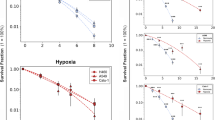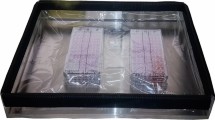Abstract
Purpose
The aim of this study was to clarify the effect of manipulating intratumor hypoxia on radiosensitivity under reduced dose-rate (RDR) irradiation.
Materials and methods
Tumor-bearing mice were continuously given 5-bromo-2′-deoxyuridine (BrdU) to label all proliferating (P) cells. They received γ-rays or accelerated carbon-ion beams at high dose-rate (HDR) or RDR with or without tumor clamping to induce hypoxia. Some mice without clamping received nicotinamide, an acute hypoxia-releasing agent or misonidazole, a hypoxic cell radio-sensitizer before irradiation. The responses of quiescent (Q) and total (= P + Q) cells were assessed by the micronucleus frequency using immunofluorescence staining for BrdU.
Results
The clearer decrease in radiosensitivity in Q than total cells after RDR γ-ray irradiation was suppressed with carbon-ion beams, especially with a higher linear energy transfer value. Repressing the decrease in the radiosensitivity under RDR irradiation through keeping tumors hypoxic during irradiation and enhancing the decrease in the radiosensitivity by nicotinamide were clearer with γ-rays and in total cells than with carbon-ion beams and in Q cells, respectively. Inhibiting the decrease in the radiosensitivity by misonidazole was clearer with γ-rays and in Q cells than with carbon-ion beams and in total cells, respectively.
Conclusion
Manipulating hypoxia during RDR as well as HDR irradiation influences tumor radiosensitivity, especially with γ-rays.
Similar content being viewed by others
References
Ahmed RS, Kim RY, Duan J, Meleth S, De Los Santos JF, Fiveash JB. IMRT dose escalation for positive para-aortic lymph nodes in patients with locally advanced cervical cancer while reducing dose to bone marrow and other organs at risk. Int J Radiat Oncol Biol Phys 2005;60:505–512.
Wulf J, Haedinger U, Oppitz U, Thiele W, Mueller G, Flentje M. Stereotactic radiotherapy for primary lung cancer and pulmonary metastases: a noninvasive treatment approach in medically inoperable patients. Int J Radiat Oncol Biol Phys 2004;60:186–196.
Hall EL, Giaccia AJ. Repair of radiation damage and the dose-rate effect. In: Hall EJ, Giaccia AJ, editors. Radiobiology for the radiologist, 6th edn. Philadelphia: Lippincott Williams & Wilkins; 2006. p. 60–84.
Hall EL, Giaccia AJ. Linear energy transfer and relative biological effectiveness. In: Hall EJ, Giaccia AJ, editors. Radiobiology for the radiologist, 6th edn. Philadelphia: Lippincott Williams & Wilkins; 2006. p. 106–116.
Hall EL, Giaccia AJ. Oxygen effect and reoxygenation. In: Hall EJ, Giaccia AJ, editors. Radiobiology for the radiologist, 6th edn. Philadelphia: Lippincott Williams & Wilkins; 2006. p. 85–105.
Vaupel P. Tumor microenvironmental physiology and its implications for radiation oncology. Semin Radiat Oncol 2004;14:197–275.
Masunaga S, Ono K. Significance of the response of quiescent cell populations within solid tumors in cancer therapy. J Radiat Res 2002;43:11–25.
Torikoshi M, Minohara S, Kanematsu N, Komori M, Kanazawa M, Noda K, et al. Irradiation system for HIMAC. J Radiat Res 2007;48(suppl):A15–A25.
Chaplin DJ, Horsman MR, Trotter MJ. Effect of nicotinamide on the microregional heterogeneity of oxygen delivery within a murine tumor. J Natl Cancer Inst 1990;82:672–676.
Wardman P. Chemical radiosensitizers for use in radiotherapy. Clin Oncol 2007;19:397–417.
Masunaga S, Ando K, Uzawa A, Hirayama R, Furusawa Y, Sakurai Y, et al. Radiobiologic significance of the response of intratumor quiescent cells in vivo to accelerated carbon ion beams compared with γ-rays and reactor neutron beams. Int J Radiat Oncol Biol Phys 2008;70:221–228.
Masunaga S, Ono K, Suzuki M, Nishimura Y, Hiraoka M, Kinashi Y, et al. Alteration of the hypoxic fraction of quiescent cell populations by hyperthermia at mild temperatures. Int J Hyperthermia 1997;13:401–411.
Hada M, Georgakilas AG. Formation of clustered DNA damage after high-LET irradiation: a review. J Radiat Res 2008;49:203–210.
Thomlinson RH, Gray LH. The histological structure of some human lung cancers and the possible implications for radiotherapy. Br J Cancer 1955;9:539–549.
Brown JM. Evidence of acutely hypoxic cells in mouse tumours and a possible mechanism of reoxygenation. Br J Radiol 1979;52:650–656.
Chan N, Koritzinsky M, Zhao H, Bindra R, Glazer PM, Powell S, et al. Chronic hypoxia decreases synthesis of homologous recombination proteins to offset chemoresistance and radioresistance. Cancer Res 2008;68:605–614.
Sprong D, Janssen HL, Vens C, Begg AC. Resistance of hypoxic cells to ionizing radiation is influenced by homologous recombination status. Int J Radiat Oncol Biol Phys 2006;64:562–572.
Masunaga S, Ono K, Abe M. Potentially lethal damage repair by quiescent cells in murine solid tumors. Int J Radiat Oncol Biol Phys 1992;22:973–978.
Masunaga S, Nagata K, Suzuki M, Kashino G, Kinashi Y, Ono K. Inhibition of repair from radiation-induced damage by mild temperature hyperthermia, referring to the effect on quiescent cell populations. Radiat Med 2007;25:417–425.
Author information
Authors and Affiliations
Corresponding author
About this article
Cite this article
Masunaga, Si., Hirayama, R., Uzawa, A. et al. Influence of manipulating hypoxia in solid tumors on the radiation dose-rate effect in vivo, with reference to that in the quiescent cell population. Jpn J Radiol 28, 132–142 (2010). https://doi.org/10.1007/s11604-009-0397-1
Received:
Accepted:
Published:
Issue Date:
DOI: https://doi.org/10.1007/s11604-009-0397-1




